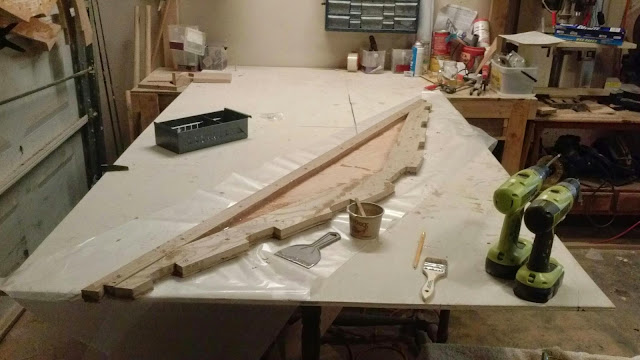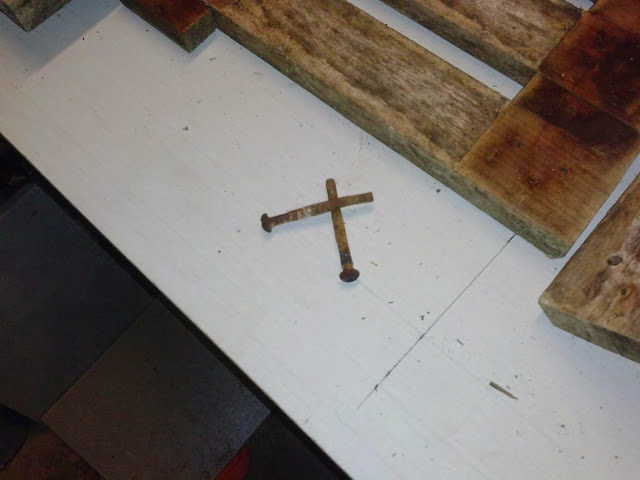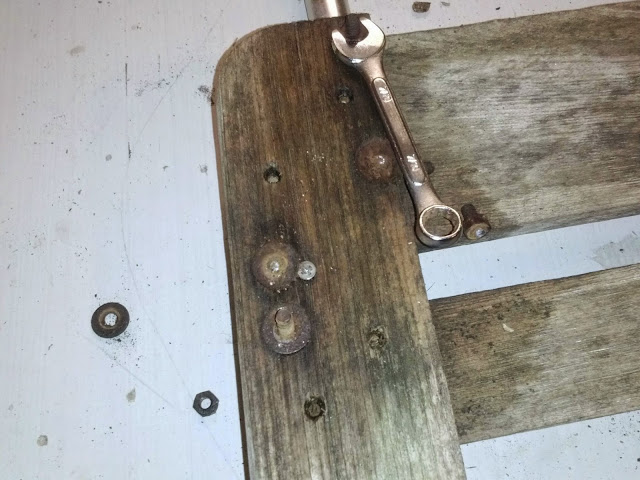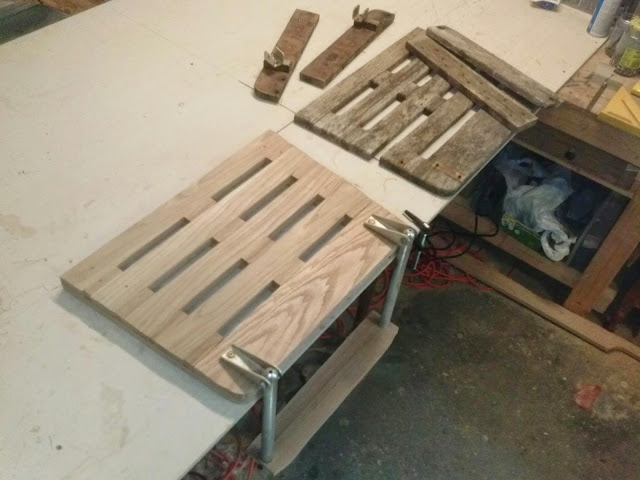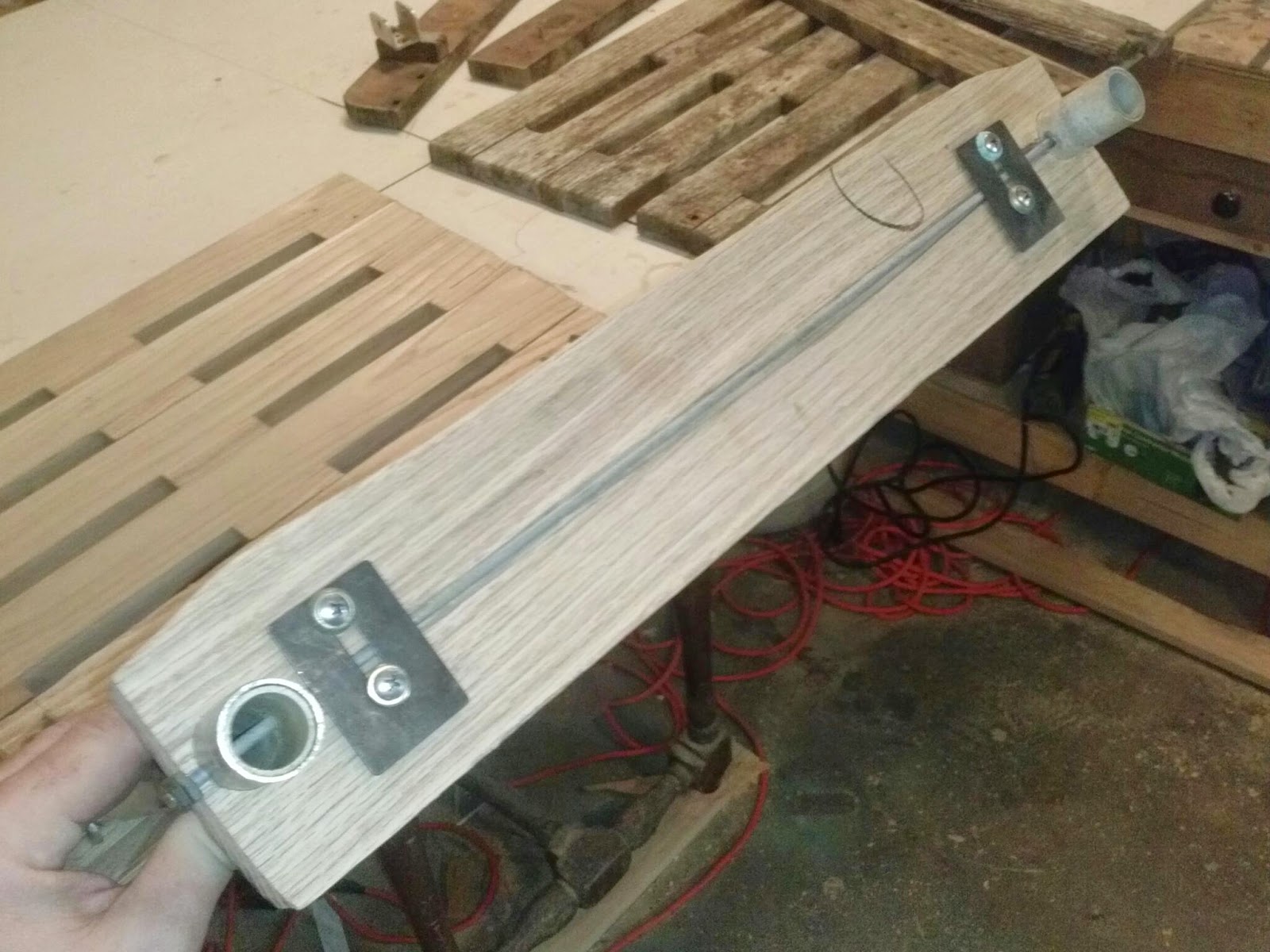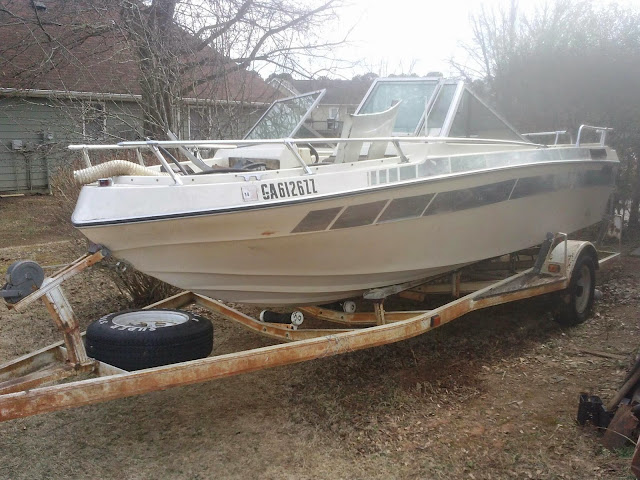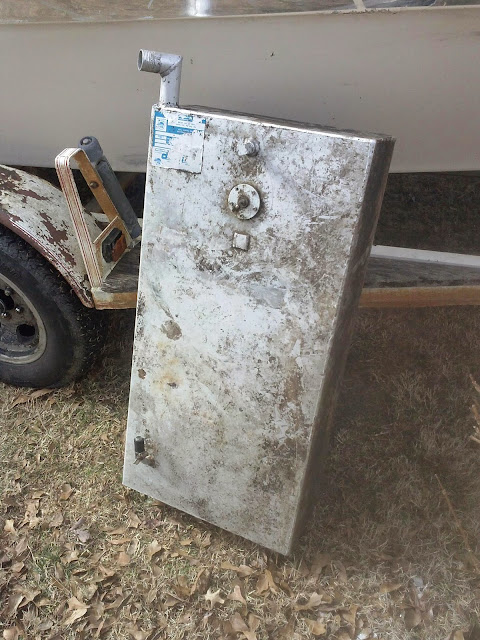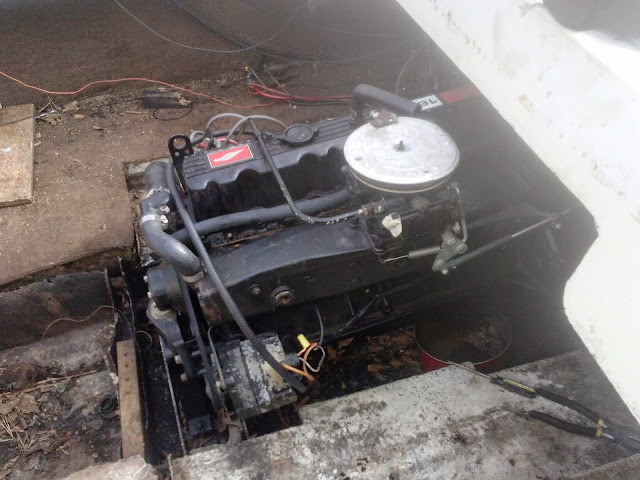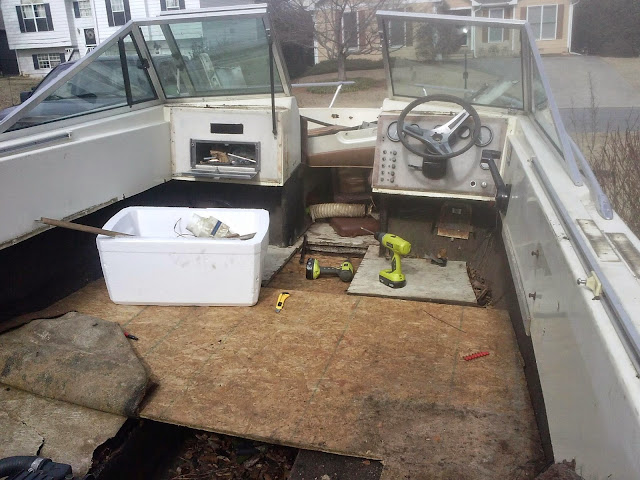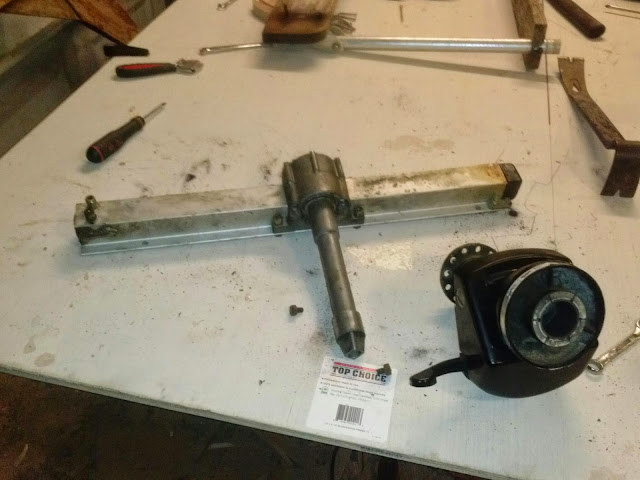Been a couple of week since I've had any boat work time. Today just wanted to get the members cut and epoxy on frame 1. This is probably the quickest frame to build but one of the hardest to glue up. I layed the frame on top of the ply and screwed through the wood frame into the ply to start with then flipped the assembly over and sent screws through the ply into the solid frame as well. Probably a little over done but I am certain it is well attached for the epoxy to setup.
I also cut the top member today for the transom. Tricky getting the angle cut across the top member. Not sure if I am going with the inboard or out board yet so I will continue on following the plans for inboard as they can be modified easier to accept outboard versus trying to add parts for an inboard.
So far had to scrap about three different boards that developed a crack while cutting frame members out. Devastating but I'll find use of them on somthing I'm sure.
Sunday, March 1, 2015
Frame #1
Sunday, February 8, 2015
Work Begins on Frame #5. All parts cut out based on templates drawn from original plan. Layout board set, lines drawn for setup level and attachment lines for the Floor Lumber. All prep work done this time to get ready for the epoxy stage.
Wax paper used to keep the frame from sticking to the work table, gloves at the ready, hammer ready for the carriage bolt insertions, clamps ready just in case, one drill set for drilling, one drill set for phillips head screw driver. All fasteners pre-staged ready to insert. Cup, Stirrer, filler, and epoxy all ready.
I have placed some blocks under each side to keep the whole frame level. Also I used a couple of scraps of 3/4 ply in the opening of the bottom of the frame where the breasthook will have to go through; thought this may help keep everything square and true (just be sure to put wax paper over the scraps if you do this).

Another overlook to make sure everything is ready.

Did Side A (the Aft Side), first then flipped the assembly over, replacing the wax paper and in hurry up fashion epoxy the second floor timber in place. This went pretty smooth since I had pre-staged for both sides.

As a word of caution, while you are dry fitting the frame together, go ahead and dry fit your bolt, washer and nut together as well. I found that the bolts (Hot Dipped Galvanized) didn't go together too smoothly. It was a little rough to get started and partly way down actually stripped the box end on the other side of the frame, so the whole bolt was turning in the whole. A good grip on a wrench was needed but I did manage to get it secured all the way down. Next bolts will all be dry fit to get them at least wrench-able.
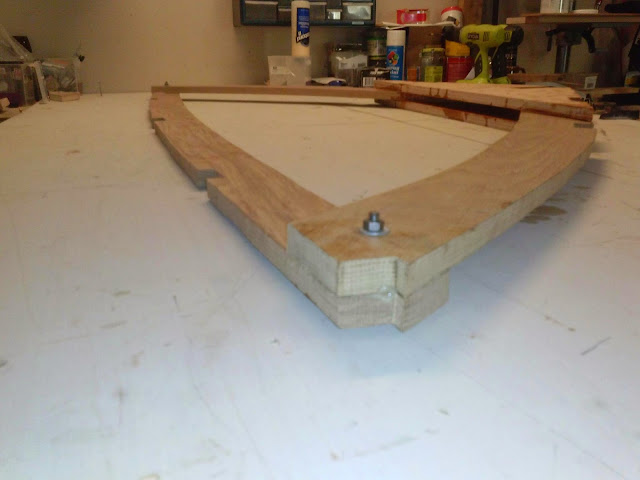
Here is a picture of that center slot where the breasthook will slip through. This slot should center the frame on the centerline.
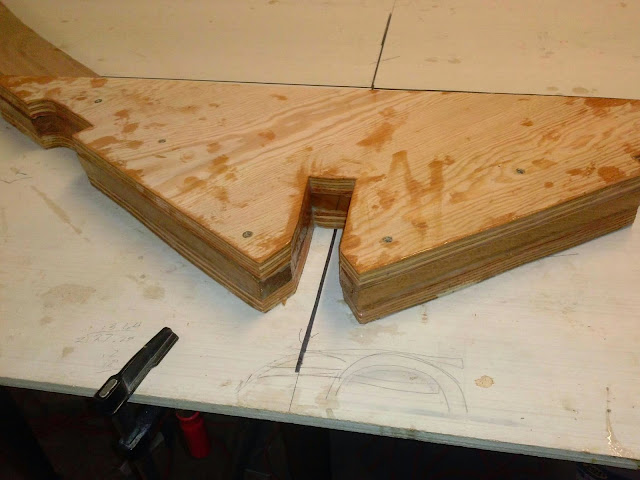
This picture shows the reliefs cut into the frame for the battons and chine.
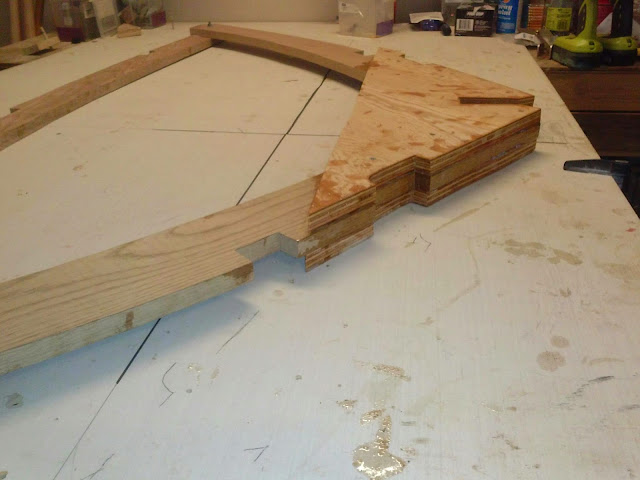
All in all, not too terribly tough on this frame. I ended up finishing mounting the deck member on Frame #4 with the bolts and so we have four completed frames as of this weekend.
Just need to finish cutting the floor beam for frame #1 and it's plywood attaching. Then we have the entire Transom to cut and put together. Saving the most complicated for last I think.
Swim Platform with folding ladder
Even if your are a fresh water only boater, I would stick to at least the SS (Stainless Steel). Here is an example of what could happen. The donor boat I bought had a really great swim platform ladder on the back of it. I think it came pretty standard on all the Somerset boats as I have seen quite a few for sale and all seem to have this great feature.
I liked it so much I want to reapply it to my build boat. New models of this same ladder run about $150. All the hardware is in pretty good shape and very sturdy despite having the steps dry rot.
In doing the tear down I noticed the manufacturer stainless screws come right out and look almost like new; not bad considering the boat is a 1982 model.
However, the nuts and bolts anchoring it to the boat are not stainless. May have been galvanized of some sort but are completely rusted out. Easy enough to remove as when you go to remove the nut, if you jerk it hard enough quickly the bolt will shear off. I think I will invest in some better fasteners since this part of the boat will always be in or nearest the water.
The plan is to replace all the wood. I will use the current wood for templates and cut each new piece, fair the edges like the current one, and reassemble with a better set of fasteners. All the aluminum will get polished and a good buffing.
I am not real sure what type of wood is the original, but I think for the time being I plan on making it out of white oak for now. If that means redoing it again down the road I will try something else next time. For now though, I think the oak will work.
I am not real sure what type of wood is the original, but I think for the time being I plan on making it out of white oak for now. If that means redoing it again down the road I will try something else next time. For now though, I think the oak will work.
Here it is disassembled. I will number each piece accordingly. The entire step tapers; wider at the stern and narrower as it gets to the ladder. As each piece is cut it will be numbered to make for easier assembly.
All the slats and spacers cut from White Oak. Not sure how that will hold up over the long haul but if I get a few years out of it before replacing the wood with something else, it will have been worth it.
Still have some fine sanding to do around the edges and will round over all the edges. Then I plan on coating it down with a good sealer after staining it to match the deck of the boat. Pretty sweet extra that came on the donor parts boat. Savings:... around $140 bucks online.
Temp mounting of the ladder. Will need to pick up about 10 more stainless steel bolts, nuts, washers to properly mount the ladder and the whole assembly to the new boat. I may find that hardware on the donor as well; it seems everything from the factory was mounted with SS, so I've been plucking as many fasteners as I can from it.

Bottom Rung step with original stabilizing rod. Still needs a good sanding but for now will do.
One Good Looking Swim Platform Ladder!
Tuesday, February 3, 2015
Donor boat for parts.
Well found a great donor boat. It has well surpassed its prime. A 1980's Somerset 17'6" ski boat. It came with a decent trailer that has new tires and newer wheels. That was the main purchase of the boat. Also had a nice aluminum 21 gallon gas tank that may work in the new build. Has a really nice swim platform ladder that I could see paying 150 for easily.
I also may be able to salvage the entire Mercruiser 165 with pre-alpha out drive. Not sure if I will be able to use that in the Roustabout... waiting to pull it out and check the weight on it. The Somerset had used a lot of flotation foam in the aft I presume to help keep the aft end afloat under the weight of that engine. Our plans for the Roustabout don't mention the use of floatation foam and I wonder if that would counteract enough to bridge the weight of the 165 in case it comes in over the 650 pound limit.
Today I spent a few hours pulling parts off the donor. First pulled the gas tank. Will end up pulling the pump out of it and sending the tank out for a good cleaning inside and outside. The pump will be replaced as well as the hoses, cutoffs, and air venting tubes. Still need to get the filler and air vent out of the donor. Not sure if I will reuse those but we shall see.
I pulled the foot off the outdrive. Thanks to Matt (previous owner) for giving it a proper greasing before I bought it! Well. I did find some excess milky puddle in the drive bellow. Definitely lube from the foot in the milky mixture. Well I knew that was going to have to be torn down anyway to go ahead and replace the water pump impeller. I may have a leaky seal in there somewhere. Exhaust and drive bellow looks ok, but shifter bellow does have a rip in it. The whole foot has been store in the up position for over a year by means of a ratchet strap, so I had already planned on pulling the bellows and replacing them anyway. Shifter cable and shift mech in the housing has a good bit of rust and corrosion on it so that too will have to get replaced. And I wasn't sure about an opening on the bottom of the gimbel housing. It looks like it was made there for the exhaust to exit but will have to research a bit further to make sure that it is supposed to be there. It seems to be in an odd place but I presume the pressure from the exhaust would keep water from coming into the exhaust system. Also found the pin for attaching the trim pistons; prior owner didn't know where it was (found in the glove box). Can't say anything about him since I pried open the glove box assuming it was locked, only to have my neighbor show me the push button that actually opens the box!
Other miscellaneous items salvaged were: a bilge pump, the full set of gauges, a few tools left by previous owners, some wooden step protectors, and a pretty nice anchor. I pulled the electrical panel, not sure if I will use it since it is pretty outdated. The bilge switch only is on/off, I plan for having an auto selection as well. But the Nav Lights switch did offer a three switch. May find some use in the new boat for some of it.
Not salvageable that I had hoped might have been: the steering system and the single arm throttle/gear shifter. I found that the steering cable was just locked up somewhere. I presume that it would be a sound investment to replace that anyway. I will take the steering column gear set and the aft steering system and see if I can locate the replacement cable before scrapping the whole system. Also I have seen where a fare bit of boaters prefer the two arm throttle/gear shifter versus the single arm. Some say it makes it a bit easier for docking and backing as well as maintenance since less parts to have failure. I also know this engine will require a little throttle to keep it going in a cold start. So I'm not too terribly dismayed about not being able to salvage these two items.
The donor boat cost a whole $150 bucks. Not bad considering I just was interested in the trailer.
Steering Mechanicals
Donor boat yields another part!
I had hoped that the entire Steering system would be reusable on this boat. However, I found that the steering cable was completely locked up. I researched the interwebs and found that it was just plain easier to replace the cable system, as they do tend to go out eventually.
Replacing the cable is find but how about the other parts? I opted to remove the under dash portion when I was removing the gauges anyway. I was only a matter of removing the two bolts at the bottom of this picture that release the cable stay barrel, and then four bolts that retain the steering gear housing. That released the internal box gear set and the steering cable came right out. Not sure if I will reuse the plastic housing that runs through the dash to the steering wheel but I will keep it just in case I cannot fabricate anything to serve the purpose.
I plan on building wheel versus reusing that plastic wheel that came on this boat. That thing was hideous! Looking more into doing a wooden three spoke wheel.
Monday, February 2, 2015
Frame #4
The Epoxy and Fasteners Stuff
This is what happens when you don't plan out the procedures. During the epoxy stages of the frames I didn't remove my gloves before grabbing my drills for drilling and screwing. The drill on the left was not cleaned the one on the right was cleaned. But in the process of making this mistake I did find out what best removes the epoxy in gel state or before.
Here's your friend in this case. GoJo works excellent in
removing epoxy from your hands or your tools during glue up stages. Now I
always recommend that you wear the proper safety material and gloves during
your build, but accidents happen. I found that if I got some of the epoxy on my
hands or tools and as long as it was still in a "wet" stage, it is
possible to scrub if off with the GoJo and a terry towel.
Also I have to recommend the eye pro. More than once I have
gotten sawdust in the eye while cutting out frame parts (especially the white
oak). These cheapo babies have more than once saved my sight. As Norm Abram
would say for good reason, "And there's no more important safety rule that
to wear these... safety glasses"
It is funny how that is one of the most memorable quotes I
can think of to date. He was a great carpenter and a great teacher. Every show
started with the same safety brief but was given on every show. A genuine
concerned fellow from an era of great do'ers.
Sunday, February 1, 2015
Frame #2 and part of breasthook
I
feel like I have wasted a lot of time going over the donor boat (last weekend
pickup and minor work to prepare for this weekend tear out). It has some good
parts on it that will save me some money in the long run but I don’t want to
get too caught up in it. Also it takes a bit to warm up the garage for epoxy.
This morning it was 50 degrees in the garage and I try to wait till I can get
it to at least 60 to 65 before any epoxy can start, and even then ideal temps
are supposed to be in the 70’s. I probably should invest in a better heater I
suppose.
Wednesday, January 14, 2015
Frame 3 begins
Been a little while since I have posted. Finally found supplier for marine ply and white oak.
I thought I had inspected the wood well enough... well not so. Upon cutting out a frame member the whole plank cracked and split in two pieces right down the middle. I therein selected not to use any part of that board. The other boards fared better and made sound cuts. So I have all the pieces for frame 3 and some pieces for frames 1, 2, 4 and 5. Shame that board broke. I would have had enough lumber to cut all frames except transom. But thats the way it goes.
Got the West Systems epoxy 105 resin and the 205 hardner. Also a couple of canisters of the 404 high density filler.
Finally got the garage up to 60 degrees tonight so I thought I would give it a go on the one frame.
Glen-L gives instrustions on how to build a layout board with centerline refernces and setup line. Found that not too dificult to setup. Still some of the cuts I made with the bandsaw originally are a little wobbly on the outter side of the frame. I hope that once it gets to the fairing portion before siding I can get the lines of the sides a bit smoother with the sander. I am certain I cant be the only person facing this delimma.
Even with the 60 degree temp in the garage the epoxy didnt heat up in the cup, nor did it go to a gel very quickly either. I am hoping it will continue to get to the right consistancy for the bonding.
I opted to use screws (stainless) for the gussetts and floor timber. On reading/studying I found general notes that nails werent really for structure holding but more of a clamping mechanism until the epoxy dries. I thought if the epoxy doesnt set right and doesn't ever solidify at least with screws I will be able to dissasemble, sand it down and try again with warmer weather.
Not a bad start, and hey we're learning here.
I thought I had inspected the wood well enough... well not so. Upon cutting out a frame member the whole plank cracked and split in two pieces right down the middle. I therein selected not to use any part of that board. The other boards fared better and made sound cuts. So I have all the pieces for frame 3 and some pieces for frames 1, 2, 4 and 5. Shame that board broke. I would have had enough lumber to cut all frames except transom. But thats the way it goes.
Got the West Systems epoxy 105 resin and the 205 hardner. Also a couple of canisters of the 404 high density filler.
Finally got the garage up to 60 degrees tonight so I thought I would give it a go on the one frame.
Glen-L gives instrustions on how to build a layout board with centerline refernces and setup line. Found that not too dificult to setup. Still some of the cuts I made with the bandsaw originally are a little wobbly on the outter side of the frame. I hope that once it gets to the fairing portion before siding I can get the lines of the sides a bit smoother with the sander. I am certain I cant be the only person facing this delimma.
Even with the 60 degree temp in the garage the epoxy didnt heat up in the cup, nor did it go to a gel very quickly either. I am hoping it will continue to get to the right consistancy for the bonding.
I opted to use screws (stainless) for the gussetts and floor timber. On reading/studying I found general notes that nails werent really for structure holding but more of a clamping mechanism until the epoxy dries. I thought if the epoxy doesnt set right and doesn't ever solidify at least with screws I will be able to dissasemble, sand it down and try again with warmer weather.
Not a bad start, and hey we're learning here.
Labels:
diy boat,
glen-l,
roustabout,
wooden boat
Location:
Cartersville, Cartersville
Thursday, January 1, 2015
Mock-up frame
Well today I thought I would try my template to make sure it would be sufficient. I had some pine laying around from prior projects and thought I would give it a go.
Simple enough. I decided to mock up frame three, since it is probably the largest of the frames being midship.
Cutting the frame member with a jig saw seemed to work best for me. I have a nine inch band saw, but I do need to switch to a courser blade before attempting that again.
Ok just going to let you know now... if your reading this I had to type it out on my phone; I left the laptop at work today. My apologie on the typos. Thumbs werent meant for blogging.
Anyway got frame three completed. So I can get a rough estimate that the templates do work. I checked the frame against the full size layout plans and was pretty happy. Also got to see roughly how it will fit within my garage and what space I will have to work around it. Not bad.
This was not a necessary step today but A fun project to do while I await the real lumber.
Simple enough. I decided to mock up frame three, since it is probably the largest of the frames being midship.
Cutting the frame member with a jig saw seemed to work best for me. I have a nine inch band saw, but I do need to switch to a courser blade before attempting that again.
Ok just going to let you know now... if your reading this I had to type it out on my phone; I left the laptop at work today. My apologie on the typos. Thumbs werent meant for blogging.
Anyway got frame three completed. So I can get a rough estimate that the templates do work. I checked the frame against the full size layout plans and was pretty happy. Also got to see roughly how it will fit within my garage and what space I will have to work around it. Not bad.
This was not a necessary step today but A fun project to do while I await the real lumber.
Templating the Plans
My first inclinations are to continue to study and get ready to purchase the lumber. However, In a recent reading of post on the Glen-L forum, I found out that templates take some time to produce to get ready before the lumber. Hmmmn. Well lets get to that.
At the hobby lobby I purchased poster board, an embalsing pen, and some graphite paper. A few years ago it was called carbon paper, now it's made a little different but still does pretty much the same thing.
Laying out the full size drawings on my largest garage table and placing the posterboard under, sandwiching the graphite paper. Utilizing the Embalsing Pen with its rounded over point I trace the lines of the plan. If you are wondering why not just cut out the parts of the plan? Well, first, these plans did cost a little bit of money. Secondly, there are parts on the plan, like the stem that are quite long and actually are drawn through other parts of the boat. You can easily make out what is what on the plan, but I did need a way to make a duplicate so I didn't end up ruining the whole lot just for one peice. I think this may be clearer once you receive your own plans you will see the connudrum I was referring to.
This process did take a little time. I was able to make temps of frames zero, three, and one as well as the breasthook, and two sets of gussets for frame three. Each different cut piece has to be templated seperately. So to make frame three, there are four seperate peices that have to be drawn seperately to make templates of the parts that go together to make the entire frame. Also marking notes on each peice as to thickness, locations, special cuts, and anything that may be useful when it comes time to layout on the wood. I even went as far as to place a reminder on the template to remember that this is only a half frame so I would need to flip the template on the centerline and draw the other half on the same board too. Anything that may be helpful when doing the layout.
At the hobby lobby I purchased poster board, an embalsing pen, and some graphite paper. A few years ago it was called carbon paper, now it's made a little different but still does pretty much the same thing.
Laying out the full size drawings on my largest garage table and placing the posterboard under, sandwiching the graphite paper. Utilizing the Embalsing Pen with its rounded over point I trace the lines of the plan. If you are wondering why not just cut out the parts of the plan? Well, first, these plans did cost a little bit of money. Secondly, there are parts on the plan, like the stem that are quite long and actually are drawn through other parts of the boat. You can easily make out what is what on the plan, but I did need a way to make a duplicate so I didn't end up ruining the whole lot just for one peice. I think this may be clearer once you receive your own plans you will see the connudrum I was referring to.
This process did take a little time. I was able to make temps of frames zero, three, and one as well as the breasthook, and two sets of gussets for frame three. Each different cut piece has to be templated seperately. So to make frame three, there are four seperate peices that have to be drawn seperately to make templates of the parts that go together to make the entire frame. Also marking notes on each peice as to thickness, locations, special cuts, and anything that may be useful when it comes time to layout on the wood. I even went as far as to place a reminder on the template to remember that this is only a half frame so I would need to flip the template on the centerline and draw the other half on the same board too. Anything that may be helpful when doing the layout.
Subscribe to:
Posts (Atom)
